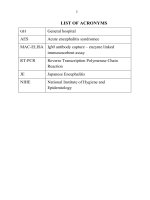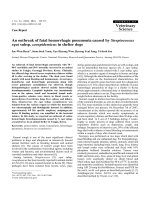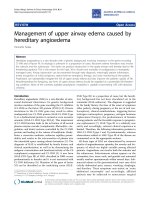The dependence of the nonlinear absorption coefficient of strong electromagnetic waves caused by electrons confined in rectangular quanfum wires on the emperafure of the system
Bạn đang xem bản rút gọn của tài liệu. Xem và tải ngay bản đầy đủ của tài liệu tại đây (596.01 KB, 6 trang )
<span class='text_page_counter'>(1)</span><div class='page_container' data-page=1>
\T,IU Journal of Science, Mathematics - Physics 26 (2010) 115-120
The
dependence
of
the
nonlinear absorption
coefficient
of
strong
electromagnetic
waves
caused
by
electrons
confined
in
rectangular quanfum
wires
on
the
temperafure of the
system
Hoang
Dinh Trien*, Bui Thi
Thu Giang, Nguyen <sub>Quang Bau</sub>Faculty of Physics, Hanoi University of Science, Vietnam National University
334 Nguyen Trai, Thanh Xuan, Hanoi, Yietnam
Received 23 December 2009
Abstract. The nonlinear absorption of a strong electromagnetic wave caused by confined electrons
in cylindrical quantum wires is theoretically studied by using the quantum kinetic equation for
electrons. The problem is considered in the case electron-acoustic phonon scattering. Analytic
expressions for the dependence ofthe nonlinear absorption coeflicient ofa strong electromagnetic
wave by confined electrons in rectangular quantum wires on the terrperature T are obtained. The
analytic expressions are numerically calculated and discussed
for
GaAs/GaAsAl rectangularquantum wires.
Keywords: rectangular quantum wire, nonlinear absorption, electron- phonon scattering.
1.
IntroductionIt
is well
known thatin
one dimensional systems, the motionof
electrons is restrictedin
twodimensions, so that they can
flow
freelyin
one dimension. The confinementof
electronin
thesesystems has changed
the
electronmobility
remarkably.This
has resultedin
a
numberof
newphenomena, which concem a reduction of sample dimensions. These effects differ from those in bulk
semiconductors, for example, electron-phonon interaction and scattering rates <sub>[1, </sub>
2]
andthe linear andnonlinear (dc) electrical conductivi$ 13,41. The problem of optical properties in bulk semiconductors,
as well as low dimensional systems has also been <sub>investigated [5-10]. However, </sub>in those articles, the
linear absorption of a weak electromagnetic wave has been considered in normal bulk semiconductors
[5], in two dimensional systems <sub>[6-7] </sub>and in quantum <sub>wire [8]; </sub>the nonlinear absorption of a strong
electromagnetic wave (EMW) has been considered in the normal bulk semiconductors <sub>[9], in </sub>quantum
wells
<sub>[0] </sub>
andin
cylindrical quantumwire
[11],but
in
rectangular quantumwire
(RQW), thenonlinear absorption of a strong EMW
is
still open for studying.In
this paper, we use the quantumkinetic quation
for
electronsto
theoretically studythe
dependenceof
the
nonlinear absorptioncoefficient of a strong EMW by confined electrons in RQW on the temperature
T
of the system. Theproblem is considered in two cases: electron-optical phonon scattering and electron-acoustic phonon
scattering. Numerical calculations are carried out
with a
specific GaAs/GaAsAl quantum wires to-
Conesponding author. Tel.: +84913 005279
E-mail:
hoangtrien@gmail,com
</div>
<span class='text_page_counter'>(2)</span><div class='page_container' data-page=2>
ll6
H.D,. Trien et al./
WU Journal of Science, Mathematics - Physics 26 (2010) 115-120show the dependence of the nonlinear absorption coefficient of a strong EMW by confined electrons
in RQW on the temperature T of the system.
2.
The dependenceof
the nonlinear absorption coefficient of a strongEMW in
a WQW on thetemperature T of the system
In our model, we consider a wire of GaAs with rectangular cross section
(Lxx
Ly)
andlength Lz ,embedded in GaAlAs. The carriers (electron gas) are assumed to be confined by an infinite potential in
the
(xry)
plane and are freein
thez
directionin
Cartesian coordinates(x,y,z ).
The laser fieldpropagates along the
x
direction.h
this case, the state and the electon energy spectra have the formlr2l
ln,(,F):#rn1!1sn1!>;
t,.,(F)=!*!f4.*,
(l)
' ,,\L,L,L,
'
<sub>L, </sub>
'
'
<sub>Ly </sub>'
<sub>2m </sub>
<sub>2m'L', </sub>
<sub>L',</sub>where
n
and| (n,
.(.:1,2,3,
...) denote the quantizationof
the energy spectrumin
thex
andy
direction,
<sub>F: </sub>
(0,0,p")
is the electron wave vector (along the wire'sz
axis),rn
is the effective massof electron (in this paper, we select
h:L).
Hamiltonian
of
the electron-phonon systemin
a rectangular quantum wirein
the presenceof
alaser field
EO:
Eosin(Qt), can be written asH(t):
<sub>I+,,(F </sub>
-9"ep11";.,.F anr.F+llou
bib,nJ,F <sub>" </sub> 4 j
+ I
c/,,,1,r(Q)alt.n*aa,,,r,p @,+blr)
(z)n,l,n' ,1',P,Q
where
e
is the electron charge, c is the light velocity<sub>, </sub>
2(D
: I
Eocosl}t) is the vector potential, ,Eoc)
and
Q
is the intensity and frequency of EMW, al,,,p (a,,,,p) is the creation (annihilation) operatorof
an electron,
b;
(ba) is the creation (annihilation) operatorofa
phonon for a state having wave vector4
,
Ca is the electron-phonon interaction constants. 1,,,,r,r(4) is the electron form factor, it is writtenas
[3]
I r,,,r,r(4) = 32 tta (q,L,nn')'
(l
-
(- l )'*''
cos (
q.L,))
[(q,L,)o
-
2 tr2 (q,L,)' (n' + n'' 7 +/
7n'-
n'' )')'
32n4 (q,L,(.(')' (I
-
<sub>1-l)t.2' cos(q </sub><sub>rLr))</sub>l@rlr)o
-2r2
(qrlr)'((t
* (,'')+
tro 71,'-
l'')'f'
The
carrier current
density
j(t)
and the
nonlinear absorptioncoefficient
of
aelectromagnetic wave
a
tzke the <sub>form [6]</sub>j
(t) =!
<sub>> </sub>
<sub><p </sub><sub>- rQ))n,,,.r(t), </sub>
o:
--!,
(j
e) E osrna),
rn
<sub>,-.2,p" </sub>
c
cJ <sub>)(*Eo</sub>where
n,,r,t(t)
is electron dishibution function,(X),
means the usual thermodynamic average1X =
j()Ersintlt
) at momentt,
26* isthe high-frequency dielectric constants.(3)
strong
(4)
</div>
<span class='text_page_counter'>(3)</span><div class='page_container' data-page=3>
H.D. Trien et al.
/
VNU Journal of Science, Mathematics - Physics 26 (2010) I I5-l 20tt7
In
orderto
establish analytical expressions for the nonlinear absorption coefficientof
a sfrongEMW
by
confined electronsin
RQW, we use the quantum kinetic equationfor
particle numberoperator of electron n,,e <sub>,p(t) </sub>
:
(a1,,,pa,,,,p) <sub>,</sub>(s)
(6)
From Eq.(5), using Hamiltonian in Eq.(2) and realizing calculations, we obtain quantum kinetic
equation for confined electrons in CQW. Using the first order tautology approximation method (This
approximation has been applied
to
a similar exercisein
bulk <sub>semiconductors [9.14] and </sub>quantumweJls <sub>[10]) to </sub>solve this equation, we obtain the expression of electron distribution function n,,rnQ) .
n,,e,F(t)
:
<sub>- </sub>I
",1c <sub>u </sub><sub>f </sub>| 1,,,,;,;
f
rt
t
r<#)J
0.,(4)
fir-"n',
4'n <sub>'t</sub>
fr <sub>,,,,p(N </sub><sub>4 </sub>
*
l)
<sub>- </sub>
F;,i,u*uN u in,t,FN
i
-
i,',r',p*a(N 4 +l)
";,i,v*4-
tn't'F + au-k(l+
i6
t;,i,7,4-
tn't,F-
au-
kC)+i6
++)
En,t,F
<sub>- t; </sub>
,i .u-u + otu
-
kcl+i5
where
N4@^.)
is the time independent componentof
the phonon (electron) distribution function,-ro
(x)
is Bessel function, the quantityd
is infinitesimal and appears due to the assumptionof
anadiabatic interaction
of
the electromagnetic wave.We
insert the expressionof
n,,,,t(t)
into <sub>lhe</sub>expression
of
<sub>7-(l; </sub>
and then insert the expressionof
<sub>J=0) into the </sub>expressionof
a
in Eq.(4). Usingproperties of Bessel function and realizing calculations, we obtain the nonlinear absorption coefficient
of a strong EMW by confined electrons in RQW
q
_
8tr"{>
y
rr
,;,i l,
<sub>Zlc4f </sub>
Nq,ilu,,,u
_i;,i,u*u),
"rhGE:
n.fr.i'"''""'
q.i,
r=<"wi
(#)5(,
; ,i ,o*u- t,,t,i *
oa-
kQ) +fau-+
-a,,l
(7)where
d(x)
is Dirac delta function.In the following, we study the problem with different electron-phonon scattering mechanisms. We
only consider the absorption close to its threshold because in the rest case (the absorption far away from
its threshold)
a
is very smaller. In the case, the condition<sub>lkO- </sub>
oolK
e
must be satisfied. We restrictthe problem to the case of absorbing a photon and consider the electon gas to be nondegenerate:
x{-i,.t.p:
niexpg!{1,
koT
"
where,
Z
is the normalization volume, no is theelectron,
ft,
is Boltzmann constant.J
,,,f+L
<sub>w!!rr,.o---a </sub>
<sub>-'- </sub>
no(er)2 <sub>(8)</sub>V(mokoT)2
</div>
<span class='text_page_counter'>(4)</span><div class='page_container' data-page=4>
118 H.D. Trien et al.
/
VNU Journal of Science, Mathematics - Physics 26 (2010) I I 5-1202.1
Electron- optical Phonon ScatteringIn this case, aq
:
ao is the frequency of the optical phonon in the equilibrium state. Theelectron-optical phonon interaction constants can be taken as <sub>t6-81 </sub>
<sub>lCrlt=lCiP </sub>
<sub>l2:e'a4(l/X*-l/xo)/2eoq2v </sub>
<sub>,</sub>here
V
is the volume, 6o is the permittivity of free space,<sub>X- </sub>
and <sub>Zo </sub>are the high and low-frequencydielectric constaqts, respectively. Inserting
Cu
into Eq.(7) and using Bessel function, Fermi-Diracdistribution function
for
electron and energy spectrumof
electronin
RQW, we obtain the explicitexpression
of
a
in RQW for the case electron-optical phonon scatteringJ-2zeonn(k^T)t''.1
I r
Id
:
+=(--;)
<sub>f </sub>
<sub>I </sub>l,,.n.o<sub>l' </sub>
<sub>fexp{,_ </sub>--(aro
-
a)}
-ll
x4ceo"tmX*C)'V
<sub>X- </sub>
<sub>Io </sub>
nd,t'
-
'kuT''
1
7T2'n'2
n''" fr.tt:**' rr**lt
+foto
+ -otor
(e)xexPlp
2mrE*
q)|r,
gmea
,"
2Korwhere
B=n'f(n''-n\ttj,+11,''-!.t1/fill2m+@o-Q,
no is
the electron densityin
RQW,
fr,
isBoltzmann constant.
2.2. Electron- acoustic Phonon Scattering
In the case, o)4
<
O
(a4
is the frequency of acoustic phonons), so we letit
pass. Theelectron-acoustic phonon interaction constants can be takpn as <sub>[6-8,10] </sub>
<sub>lCul'=lCi" </sub>
<sub>l2= </sub>(2q/2pu,V, hereV,
p,_%, and
(
are the volume, the density, the acoustic velocity and the deformation potential constant,respectively. In this case, we obtain the explicit expression
of
a
in
RQW for the case ofelectron-acoustic phonon scattering
o-Jzmtre'no€'(koT)tt'
r lr
,,1, exp{
| Lr{*tr*
+crf-4*pfiAtV
<sub>n.4.,''"'''n"t'| </sub>
"'I''koT
2m\I:
' I]
"
^where D =
x'f(n''
<sub>- </sub>
n')/4
+ (.''z<sub>- </sub>
1.1/4)-o
From analytic expressions of the nonlinear absorption coefficient
of
a strong EMW by confinedelectrons
in
RQWswith
infinite
potential (Eq.9 andEq.l0), we
see that the dependenceof
thenonlinear absorption coefficient of a strong electromagnetic wave by confined electrons in rectangular
quantum wires on the temperature
T
is complex and nonlinear. In addition, from the analytic results,we also see that when the term
in
proportional to quadratic the intensityof
the EMW 1Eo2)
(in theexpressions of the nonlinear absorption coefficient of a strong EMW) tend toward zero, the nonlinear
result
will
turn back to a linear result.3.
Numerical results and discussionsIn
order
to
clarif,
the
dependenceof
the
nonlinear absorption coefficientof a
strongelectromagnetic wave by confined electrons in rectangular quantum wires on the temperature T, in this
</div>
<span class='text_page_counter'>(5)</span><div class='page_container' data-page=5>
H.D. Trien et al.
/
WU Journal of Science, Mathematics - Physics 26 (2010) I l5-120 119section,
we
numerically' calculate the nonlinear absorption coefficientof
a
strongEMW
for
aGaAslGaAsAl RQW. The parameters of the CQW.The parameters used in the numerical calculations
[6,13]
are
{:13.5eV,
p:5.32gcffi-3, u,:5378ms-t,
eo:L2.5,
<sub>7-:10.9, </sub>
<sub>Io:13.1,</sub>
m:0.066m0,
mo being
the
massof
free
elechon,ha:36.25meV,.ku:1.3807x10-"
jlK,
flo:1023
*-t
<sub>? </sub>":l.602l9xlo-te
C,
h:1.05459 x 10-3a 7.s .100
150
200
250
3(Temperature of the system (K)
Fig.2. Dependence of
a
on T(Electon- <sub>acoustic Phonon Scattering).</sub>
Figure 1 shows the dependence of the nonlinear absorption coefficient of a stong EMW on the
temperature T of the system at different values of size
L,
andZ, of wire in the case of electron- opticalphonon scattering.
It
can be seen from this figure that the absorption coefficient depends strongly andnonlinearly on the temperature T of the system. As the temperature increases the nonlinear absorption
coefficient increases until
it
reached <sub>the maximum value (peak) and then </sub><sub>it </sub>
<sub>decreases. </sub><sub>At </sub>
<sub>different</sub>values of the size
L'
and L, of wire the temperature T of the system at which the absorption coefficientis the maximum value has different values. For example <sub>, </sub>at L* =
L, :25nm
and L* =L, :26nm
,
thepeaks correspond
to
f -
180K and T<sub>-I30K, </sub>
respectivelyFigure 2 presents the dependence of the nonlinear absorption coefficierit
aonthe
temperature Tof the system at different values of the intensity E6 of the external strong electromagnetic wave in the
case electron- acoustic phonon scattering. It can be seen from this figure that like the case
ofelectron-optical phonon scattering, the nonlinear absorption coefficient
a
has the same maximum value butwith
different valuesof T.
For example,?t
Eo=2.6x106V/mand.
Eo=2.0x106Vlm,
the peakscorrespond
to
T<sub>=170K </sub>
and
T<sub>-190K, </sub>
respectively,this
fact was
not
seen
in
bulksemiconductorsf9] as well as in quantum wells[l0], but it fit the case of linear absorption [8].
4. Conclusion
kt
this paper) we have obtained analytical expressionsfor
the nonlinear absorptionof
a sfrongEMW by confined electrons in RQW for two cases of electron-optical phonon scattering and
electron-acoustic phonon scattering.
It
can be seen from these expressions that the dependance of the nonlinearFig. 1. Dependence of
a
onT(Electron- optical Phonon Scattering). <sub>.</sub>
1
0
1
c
.9
.o
l=
o)
o
o
c
.9
o-o
o
-o<sub>(It</sub>
o
0)
:
<sub></sub>c-o
z
-Eo=2.g11g0 1v/m1</div>
<span class='text_page_counter'>(6)</span><div class='page_container' data-page=6>
120 H.E. Trien et al.
/
WU Journal of Science, Mqthematics - Physics 26 (2010) 115-120absorption coefficient of a strong electomagnetic wave by confined electrons in rectangular quantum
wires on the temperature T is complex and nonlinear. In addition, from the analytic results, we also see
that when the term in proportional to quadratic the intensity of the EMW (Eo2) (in the expressions
of
the nonlinear absorption coefficient of a strong EMIV) tend toward zero, the nonlinear result
will
turnback to a linear result. Numerical results obtained for
a
GaAslGaAsAI CQW show thata
dependsstrongly and nonlinearly
on
the temperatureT
of
the
system.As
the temperature increases thenonlinear absorption coefficient increases
until
it
reached the maximum value (peak) and thenit
decreases. This dependence is influenced by other parameters of the system, such as the size Lrand
L,
of wire, the intensity Eo of
the
strong electromagnetic wave. Specifically, when the intensity Eo of thestrongielecfromagnetic wave (or the size
L,
andZ, of wire) changes the temperature T of the system atwhich the absorption coefficient is the maximum value has different values. , this fact was not seen in
bulk semiconductors[9] as well as in quantum wells[l0], but it fit the case of linear absorption <sub>[8].</sub>
Acknowledgments.
This work
is
completedwith
financial supportfrom the
Viebram NationalFoundation for Science and Technology Development (103.01.18.09).
References
[1] N. Mori, T. Ando,Pftys. Rev.B,vol40 (1989) 6175.
12) J.Pozel4 V. Juciene, Sov. Phys. Tech. Semicond,vol29 (1995) 459.
[3]
P. Vasilopoulos, M. Charbonneau, C.N. Van Vlier, Plys. Rev,B,vol35 (1987) 1334.[4]
A. Suzuki,Phys. Rev.B,vol45 (1992)6731.[5]
G.M. Shmelev, L.A. Chaikovskii, N.Q, Bau, Sov. Prys. Tech. Semicond,vol 12 (1978) 1932,[6] N.Q, Bau, T.C. Phong, <sub>"t </sub>Phys. Soc. Japan,vol 67 (1998) 3875.
[7]
N.Q. Bau, N,V. Nhan, T.C. Phong, <sub>"/. </sub>Korean Phys. Soc, vol 4l (2002) 149 .[8] N.Q. Bau, L. Dinh, T.C. Phong, <sub>"I </sub>Korean Phys. Soc, vol 5l (2007) 1325.
[9]
V.V. Pavlovich, E.M. Epshtein, Sov. Phys. Solid State,vol 19 (1977) 1760.[10] N.Q. Bau <sub>, </sub>D.M. Hunh, N.B. Ngoc, <sub>"/. </sub>Korean Phys.,Soc, <sub>vol 54 Q009)765.</sub>
U 1] N.Q. Bau, H.D. Trien,l Korean Phys. Soc, vol 56 (2010) 120.
[12] T.C. Phong, L. Dinh, N.Q. Bau, D.Q. Vuong, .t Korean. Phys. Soc,vol49 (2006)2367.
[3]
R. Mickevicius, V. Mitin, Plys. Rev. B, vol 48 (1993) 17194'</div>
<!--links-->









